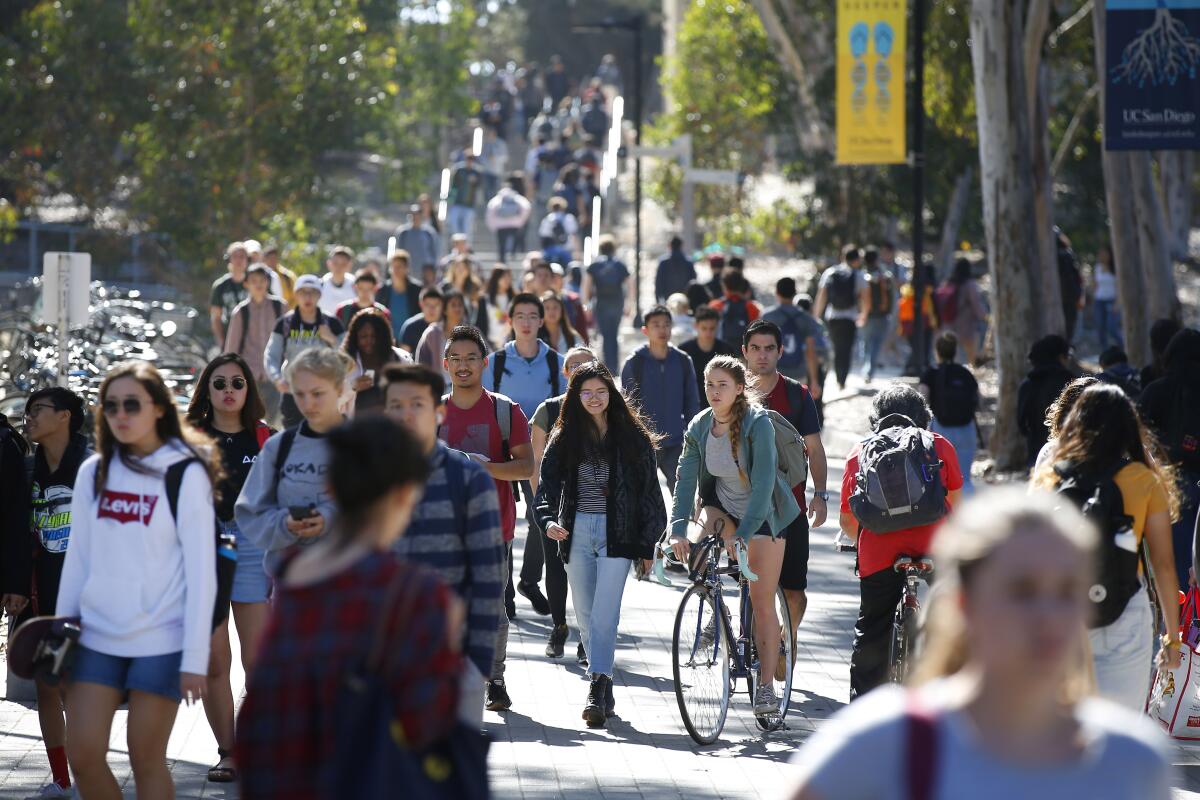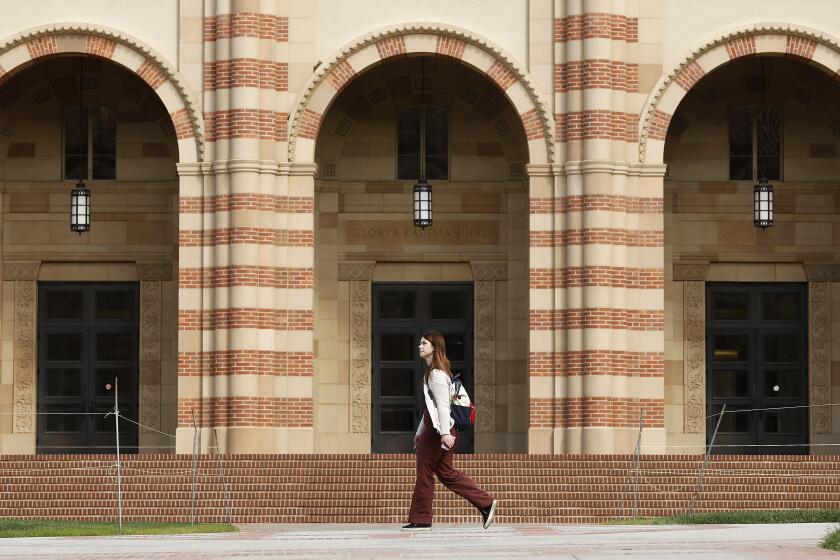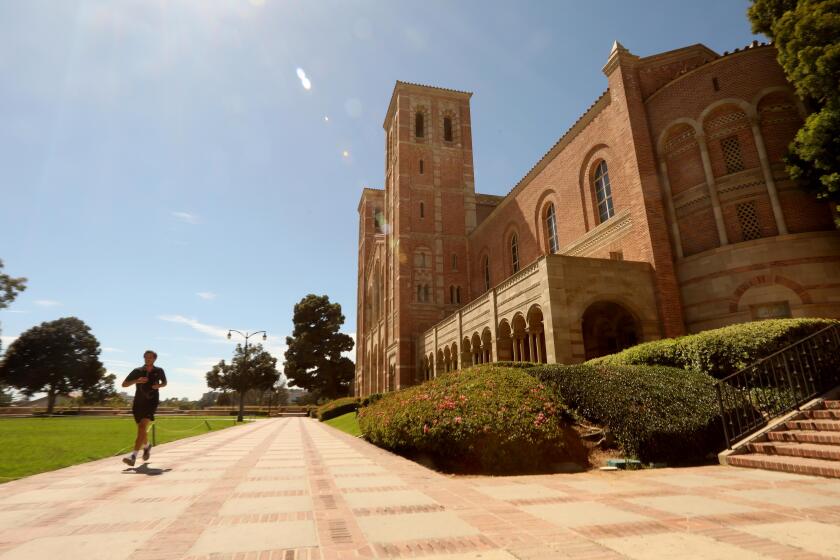UC applications slow down for fall 2023. Will Californians get a better shot at admission?

- Share via
After two years of record growth, the University of California received a smaller number of applications for fall 2023, with state students holding steady but nonresidents declining, according to preliminary data released Friday.
Overall, UC drew 206,405 applications for first-year seats, a 2% decline from last year, with international students accounting for the steepest drop. The number of California first-year applicants stayed essentially flat overall at 132,226 — increasing at six of the nine UC undergraduate campuses and slightly declining at UCLA, UC Davis and UC Merced.
But as UC plans to increase the enrollment of California undergraduates by 4,200 this fall under an agreement with Gov. Gavin Newsom, the chance of admission may be a tad better. Although campuses won’t release their admission decisions until next month, they accepted a record number of California first-year students last year, while significantly narrowing entry to out-of-state and international applicants amid demands to preserve seats for state residents.
Campuses expect to continue that trend this year. UCLA, UC San Diego and UC Berkeley are again planning to swap out about 900 nonresident students, giving those seats to Californians, under a deal with Newsom and legislators to make up losses in the higher tuition paid by out-of-state and international students.
Despite the dip for fall 2023, the number of first-year applications is still higher than it was in 2021, the start of a two-year record surge that campus officials largely attribute to the elimination of standardized testing requirements for admission. Six of the 10 most applied to universities in the nation are UC campuses.
As the University of California confronts record demand for admission, lawmakers are considering a plan to cut in half the share of nonresident students to make more room for locals.
“The University of California received an impressive number of applications for admission from prospective students this year. This is a testament to the University’s continued reputation as a premier center of higher learning,” UC President Michael V. Drake said in a statement. “A UC education prepares students for the future, positions them for expanded opportunities and encourages them to have a positive impact on their communities.”
But the high demand has meant lower admission rates, especially at the most popular campuses.
Admission rates for California first-year students declined at UC Berkeley to 14.5% for fall 2022 from 16.9% the previous year. They dropped even lower at UCLA, to 9.2% from 9.9% during that same period. Systemwide, admission rates for California students declined to 64.4% last fall from 65.7% the previous year.
Among California first-year applicants for fall 2023, Latinos again made up the largest share at 39%, followed by Asians at 31%, white applicants at 21%, Black students at 6% and American Indians and Pacific Islanders at 1% or less. Those proportions are roughly similar to last year, with a slight increase for Latinos and a small decline for Black students.
And the significant decrease in transfer student applicants that began during the pandemic has slowed. Transfer student applications dipped to 39,363 for fall 2023 — a 2.4% decline from last year compared with a 12.6% drop between 2021 and 2022, when the pandemic brought plunging enrollment in California community colleges.
UC San Diego and UC Berkeley managed to increase their California transfer applicants for fall 2023 — a key focus of state policymakers who are pushing to simplify the process from community colleges to UC campuses.
Jim Rawlins, UC San Diego associate vice chancellor of enrollment management, said the campus strengthened efforts to make sure community college students and counselors understood the coursework needed to apply to certain majors. The campus also extended the application deadline from November to January — resulting in about 100 additional applicants.
The potential enrollment increase at the University of California would be the equivalent of a new campus.
“If little steps like that help a few students, then great, that’s our doing our part as good neighbors to the community colleges,” Rawlins said. “And the feedback we got from them suggests that’s really, really helpful.”
UC Berkeley also drew slightly more California first-year and transfer applicants for fall 2023 — 72,656 and 16,112, respectively. The campus decided to step up recruiting events in more regions of California even during the pandemic, when many institutions pulled back, admissions officials said. One event, “Power in Community,” brought underserved students from Northern California to campus to hear from administrators and others about financial aid, support services and student groups.
UC Santa Barbara admission director Lisa Przekop said her campus also redoubled efforts to attract California applicants while putting less focus on international and out-of-state students. Her team has not traveled to key recruiting areas of Asia and South Asia since the pandemic and decided not to host virtual sessions this year for students there due to the time difference — which had required admissions officers to present in the middle of the night.
At the same time, Przekop said, UC Santa Barbara held more than 1,000 informational sessions for students throughout California. Thanks to an easing of pandemic restrictions, admission officers began traveling to high schools and college fairs again while continuing online webinars, some in Spanish, and intensifying social media outreach.
Gov. Gavin Newsom has directed UCLA to guarantee admission for eligible transfer students but legislative analyst and UC faculty leaders question the plan’s focus and feasibility.
The result: California first-year applications have steadily grown to 74,902 for fall 2023 from 73,575 and 71,209 during the previous two years. Applications declined slightly for out-of-state and international students and transfer students.
“I really don’t see our numbers as a decline because the reality is that we grew in California, and that’s where we were putting our efforts,” Przekop said. “We were much more visible.”
UC Irvine was one of three UC campuses with increased applications overall. First-year applications increased to 121,074 for fall 2023 from 119,165 last year, while transfer applications dipped slightly. But the total 143,000 applications set a record for the third consecutive year.
Dale Leaman, UC Irvine executive director of undergraduate admissions, said he was especially heartened that the drop in transfer applicants was smaller. “I’m counting it as a win,” he said. “In talking to several community college colleagues ... there is a recovery there in student engagement and interest in returning back.”
He said the 2023 admission cycle, after two years of uncertainty triggered by the COVID-19 upheaval and the elimination of standardized testing, could mark a return to pre-pandemic trends. UC applications had declined in 2019 and 2020 before the surge began in the last two years.
Total UC Riverside applications increased to 68,058, with nearly 2,100 more California and nonresident students seeking first-year seats. Emily Engelschall, associate vice chancellor of enrollment services, credited a new marketing campaign, along with a return to a fully staffed admissions team that visited 13% more schools and completely restored the in-person campus tour experience for the first time since the pandemic.
“Coming off the pandemic, we really felt it was important to reinvest in those in-person connections with our counselors, with our student community, with families to go out and tell our story,” Engelschall said.
The Riverside campus also extended its deadline for transfer applications until the end of January, drawing 1,000 additional applications, although overall numbers declined slightly from last year.
UC Merced also extended filing deadlines for all students, drawing nearly 400 more applications. Although the preliminary data released by the UC Office of the President showed a decline in applications at Merced, campus officials said the extended deadline helped draw a final count of more than 26,000 first-year applications, a record.
UC Davis application numbers stayed essentially flat for first-year students, at 94,609, and declined slightly for transfer students, to 14,741. UC Santa Cruz increased overall applications, with 68,820 first-year applicants — an increase of nearly 1,800 over last year — and 11,140 prospective transfer students, a slight decline.
At UCLA, both first-year and transfer applications fell but the Westwood campus remained the most popular choice for students from California, along with other states and countries. UCLA received 145,882 first-year applications and 23,954 transfer applications.
Gary Clark, UCLA interim vice provost of enrollment management, said the campus had not yet determined how many additional students UCLA would admit this year. But he said he was relieved that a decline in applications would mean fewer disappointed students who don’t get the coveted acceptance letter next month.
“Even with a slight decrease, we’ve got a great pool of applicants to choose from, so we feel pretty good,” Clark said.
More to Read
Sign up for Essential California
The most important California stories and recommendations in your inbox every morning.
You may occasionally receive promotional content from the Los Angeles Times.














